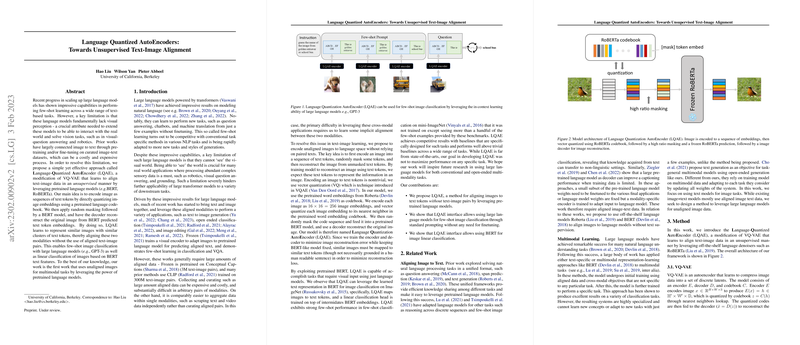Language Quantized AutoEncoders: Towards Unsupervised Text-Image Alignment
In the field of machine learning, the paper titled "Language Quantized AutoEncoders: Towards Unsupervised Text-Image Alignment" proposes a novel approach to overcome the limitations of LLMs, such as GPT-3 and BERT, which lack visual perception. This deficiency restricts their applicability in domains requiring visual inputs, such as visual question answering (VQA) and robotics. The authors introduce a method called Language-Quantized AutoEncoder (LQAE), which represents a significant shift from traditional reliance on curated image-text datasets for multimodal learning.
Methodology
The core idea behind LQAE is to encode images as sequences of text tokens by directly quantizing image embeddings using a pretrained language codebook (e.g., RoBERTa). Here are the key steps:
- Image Encoding: Images are encoded into sequences of text tokens using a pretrained LLM's codebook.
- Random Masking: The sequences undergo random masking, similar to the token masking in BERT.
- Prediction and Reconstruction: A BERT model predicts the masked text tokens, and a decoder reconstructs the original image from these predicted text tokens.
This approach ensures that similar images produce similar clusters of text tokens, facilitating alignment between the visual and textual modalities without requiring paired text-image datasets.
Experimental Evaluation
The experimental setup demonstrates that LQAE can be employed for few-shot image classification using LLMs and linear classification of images based on BERT text features. Several notable experiments and results are discussed:
- Linear Classification: Using intermediate representations of RoBERTa, the LQAE's performance in linear classification on ImageNet dataset significantly outperformed traditional VQ-VAE encoder representations.
- Few-Shot Classification: LQAE was evaluated on Mini-ImageNet 2-way and 5-way few-shot tasks, showing competitive or superior performance to baselines that had access to large text-image-aligned datasets. Notably, LQAE did not use any text-image pairs during training, making the results more striking.
Results and Findings
The results showcase several impactful findings:
- Unsupervised Text-Image Alignment: Achieving high accuracy in few-shot learning without aligned data underscores the potential of unsupervised learning approaches.
- Human Readability Not Essential: The generated text tokens need not be human-readable, yet they retain sufficient internal structure for LLMs to leverage effectively in few-shot learning.
- Masking Ratio: Experiments revealed that a higher masking ratio (around 50%) was necessary for optimal performance, deviating from the conventional 15% used for language denoisers like BERT.
Critical Analysis and Future Implications
While LQAE brings significant advancements, several points merit further exploration:
- Interpretability: The text representations, though effective, are not human-readable. Future research might focus on making these representations human-interpretable without sacrificing alignment quality.
- Scalability: Scaling the model with larger image encoders and BERT models could yield even better results. However, this requires substantial computational resources.
- Generalization: Extending this technique to other modalities (e.g., audio, video) and exploring its generalizability could open up new applications in multimodal learning.
Conclusion
The Language Quantized AutoEncoder (LQAE) provides a robust framework for aligning text and image modalities without the need for curated datasets. Its ability to facilitate few-shot learning using LLMs marks a significant step forward in unsupervised multimodal learning. This method not only improves the practical utility of LLMs in visual tasks but also paves the way for future research into more sophisticated and scalable unsupervised learning techniques. The implications for AI are broad, promising advancements in fields that demand integration of diverse data modalities.
